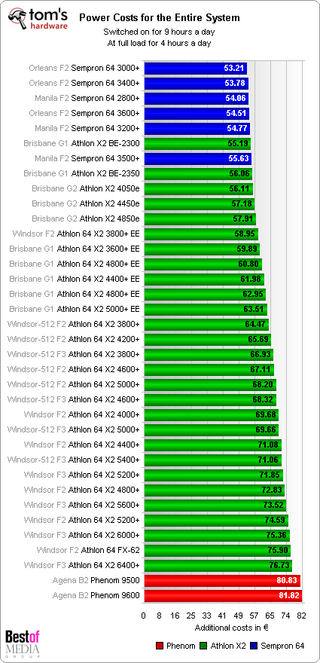35 AMD CPUs Tested for Power Consumption
Electrical Costs: For an Average User
We calculated the yearly electrical costs for an average user. Our user leaves the computer on for 9 hours a day and runs the CPU at 100% for 4 hours a day. We used these values to create our average user profile.

If the computer is equipped with the most energy efficient Sempron, the 64 3000+, the PC system’s energy costs (excluding monitor) are about $82 (53.21 Euros) per year. The smallest Dual-Core BE processor only costs $3.05 (1.98 Euros) more per year.
At $124.50 (80.83 Euros), the Quad-Core Phenom system is better than the Athlon 64 X2 6400+. The two times higher energy consumption of the Phenom during standby is not noticeable for the average user when compared to the fastest Dual-Core Athlon: there is only about $6.32 (4.10 Euros) more in electrical costs over the year. It’s obvious that the Phenom processor has the highest energy costs out of all of the AMD desktop processors.
Stay on the Cutting Edge
Join the experts who read Tom's Hardware for the inside track on enthusiast PC tech news — and have for over 25 years. We'll send breaking news and in-depth reviews of CPUs, GPUs, AI, maker hardware and more straight to your inbox.
Current page: Electrical Costs: For an Average User
Prev Page Energy Costs: When Cool'n'Quiet Mode Doesn’t Work Next Page Electrical Costs: the 24-Hour System-
Excellent article! It would be nice to see similar article for Intel processors because even if they are less power hungry, the Intel chipsets are not the "greenest". I am just considering a 24/7 home server and this information is very useful for me. Thank you!Reply
-
Good article! You have the wrong processor name listed for the 2.10 GHz G1 Brisbane as "Athlon 64 X2 4800+ EE". It should be 4000+. I was a bit confused when I read the performance charts and noticed two 4800+ listed until I realized the mistake.Reply
-
xoham Intel is not the greenest if it is less power hungry? Do they not meet RoHS standard or something?Reply -
zenmaster He said the "Intel Chipsets" are not the greenest.Reply
The are still built on the 90nm process.
The P45 will introduce the 65nm process on the chipsets.
The latest AMD Chipsets use the 55nm process.
In regards to CPUs, The Intel CPUs generally use less than the AMD CPUs.
He was simply pointing out that the CPUs lose some of the benefeit of their low power consumption due to the chipset.
For lower-end chips sitting idle, the difference in power usage of the chipsets can be significant. If you are looking at a higher-end chip under load, the power usage of the chipset becomes nominal. -
einheriar besides that intel still has the memory controller as a separate chip on the motherboard, where as amd has that included on the chip.. therefor a higher chip power use might be offset by the absence of the external memory controller, which would become visible when idling ..Reply -
so my x2 4000 ee (in tables interpreted as one of 4800's - due mistake) isn't so bad after all, I don't care about 2w/hour, when I have 24" lcd :-)Reply
-
Mathos The extra power consumption on the Phenom is due to the fact that the NB/IMC voltage stays at 1.250v even when the rest of the processor is running in standby. Kinda of annoying that they put it that high, since with a bios that still has the p-states section you can easily under volt the IMC without losing stability, especially at stock speeds. That will cut down on the idle and load power usages drastically.Reply -
royalcrown I like how review site all push efficiency now since AMD can't really compete on performance. Yawn.Reply -
jprevost Bravo for a great technical article. I can't tell you guys how nice it is to see some great charts. Charts are good, and you guys are good at charts, just don't stop adding to them!Reply
